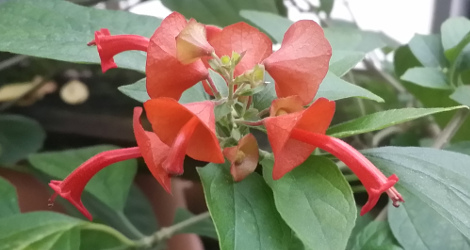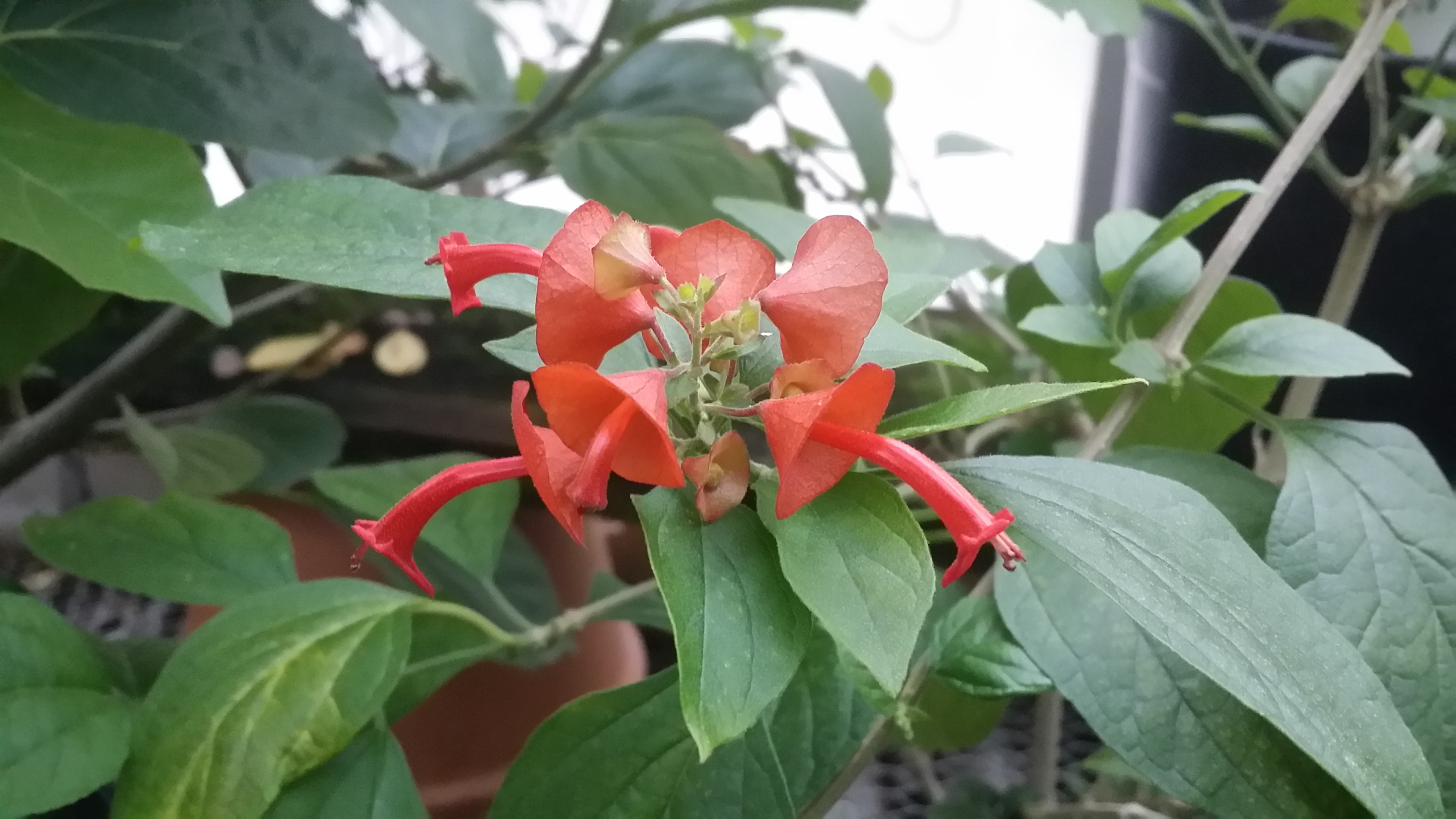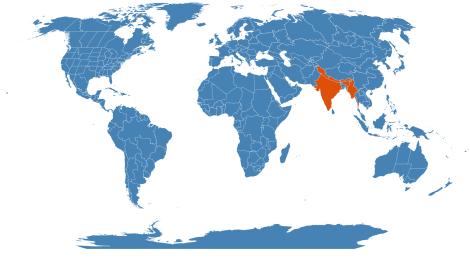Accession Data
Holmskioldia sanguinea
Common Name: Chinese Hat
Family: Lamiaceae
Country of Origin: Himalaya to Myanmar
Description: Shrub, straggling or liana up to 10-20 ft high. Bark dark brown or grey, smooth, peeling off in to narrow papery strips, branches and branchlets slender, acutely quadrangular, pubescent when young and glabrous when mature, nodes annulate. Leaves simple, opposite, broadly ovate-elliptic or broadly lanceolate, 4-11 x 2.5-7, base rounded to subcordate, margins finely crenate-serrate, apex acuminate or abruptly cuneate, chartaceous, lateral veins 4-7 on either side of the midrib, minutely pubescent above, pubescent on veins and gland-dotted beneath, ascending, margins arcuate, petiole slender, canaliculated about 1-3 cm long, exstipulate. Inflorescence cymose racemes, axillary and terminal, about 5 cm long, subtending petiole, bract ovate or elliptic, apex acute. Flowers bisexual, red, glabrous, pedicel about 1 mm long, calyx saucer shaped, minutely 5 toothed, red, yellow, orange, membranous, minutely pubescent or glabrous, about 2.5 cm long, corolla infundibular, 5 lobed, lobes obtuse, red, orange, or usually the same colour of the calyx, about 4 mm long, corolla tube narrow, cylindric, slightly ampliate towards the apex, pubescent, about 2 cm long, and 0.5 cm wide, stamens 4 didynamous to subequal, exserted, filaments slender, slightly hairy, about 1.5-2.5 cm long, anther oblong or ovoid, white, ovary conical, glabrous, style slender, filiform, almost same coloured as the calyx and corolla, about 1.5-2.5 cm long, stigma bi-lobed. Fruit drupe subglobose, about 1 cm in diameter, deeply 4 lobed at the apex, splitting into 4 pyrenes, seeds 1-4, verrucose, fruiting calyx accrescent, endocarp hard.4
Accession Data
USDA Zone: 10-11
Accession #: 200500019
Accession Date: 2005-04-07 00:00:00
Bloom Status: 🌸 Flowering
Location: 1207
Quantity: 3
Source: Joan Leonard - Ohio State
Culture: Its long, trailing canes make it ideal for espaliering. Rampant growth can be contained by pruning after flowering and old canes can be removed. There are also yellow- and bronze-flowered forms.
Classification
Division: Magnoliophyta
Class: Magnoliopsida
Subclass: euasterid I
Order: Lamiales
Family: Lamiaceae
SubFamily: Scutellarioideae
Flowering Data:
This accession has been observed in bloom on:| Year | Jan | Feb | Mar | Apr | May | Jun | Jul | Aug | Sep | Oct | Nov | Dec | ||||||||||||||||||||||||||||||||||||||||
|---|---|---|---|---|---|---|---|---|---|---|---|---|---|---|---|---|---|---|---|---|---|---|---|---|---|---|---|---|---|---|---|---|---|---|---|---|---|---|---|---|---|---|---|---|---|---|---|---|---|---|---|---|
| 2025 | ||||||||||||||||||||||||||||||||||||||||||||||||||||
| 2024 | ||||||||||||||||||||||||||||||||||||||||||||||||||||
| 2023 | ||||||||||||||||||||||||||||||||||||||||||||||||||||
| 2022 | ||||||||||||||||||||||||||||||||||||||||||||||||||||
| 2021 | ||||||||||||||||||||||||||||||||||||||||||||||||||||
| 2020 | ||||||||||||||||||||||||||||||||||||||||||||||||||||
| 2019 | ||||||||||||||||||||||||||||||||||||||||||||||||||||
| 2018 | ||||||||||||||||||||||||||||||||||||||||||||||||||||
| 2017 | ||||||||||||||||||||||||||||||||||||||||||||||||||||
| 2016 | ||||||||||||||||||||||||||||||||||||||||||||||||||||
| 2015 | ||||||||||||||||||||||||||||||||||||||||||||||||||||
| 2014 | ||||||||||||||||||||||||||||||||||||||||||||||||||||
| 2013 | ||||||||||||||||||||||||||||||||||||||||||||||||||||
| 2012 | ||||||||||||||||||||||||||||||||||||||||||||||||||||
| 2011 | ||||||||||||||||||||||||||||||||||||||||||||||||||||
| 2010 | ||||||||||||||||||||||||||||||||||||||||||||||||||||
| 2009 | ||||||||||||||||||||||||||||||||||||||||||||||||||||
| 2008 | ||||||||||||||||||||||||||||||||||||||||||||||||||||
| 2007 | ||||||||||||||||||||||||||||||||||||||||||||||||||||
| 2006 | ||||||||||||||||||||||||||||||||||||||||||||||||||||
| 2005 | ||||||||||||||||||||||||||||||||||||||||||||||||||||
References
- Botanica, Turner & Wasson, 1997, CD-ROM Version
- The Plant List (2013). Version 1.1. Last accessed on Thursday, August 17, 2017.
- WCSP (2015). World Checklist of Selected Plant Families. Facilitated by the Royal Botanic Gardens, Kew. Last accessed on Thursday, August 17, 2017.
- Holmskioldia sanguinea at India Biodiversity. Last accessed on Thursday, August 17, 2017.
Images


